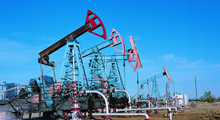Hot underground pipeline and soils and seasonal cooling devices: thermal interference
May 26, 2014

Hot underground pipeline and soils and seasonal cooling devices: thermal interference
Oil Industry Journal № 05/2014 has published an article by D.S. Pazderin (Giprotymenneftegaz, HMS Group) on Hot underground pipeline and soils and seasonal cooling devices: thermal interference.Value of negative temperature is the upmost attribute to define strength of permafrost soils and thus, their bearing capacity when using for pipeline foundations. As a consequence, transfer of soils from plastic frozen to solidly frozen state both ensures higher safety of installations at unexpected temperature variations of permafrost soils, and is more economically effective. Most efficient ones, as per freezing efficiency and ease of operation and economic feasibility, are self-regulating seasonal cooling devices (SCD) with close-ended convection of V/L heat transfer fluid (ammonia, carbon dioxide, Freon gas). Close-ended convection units of V/L heat transfer fluid are featured for high freezing efficiency, as phase transitions occur with absorption and release of big amount of heat (e.g, 1300 kJ/kg for ammonia). The article considers thermal interference issues of a hot pipeline with permafrost soils in conditions of thermostabilisation applying the single vertical SCD. Boundary conditions on the pipeline – soil border, SCD - soil, and air – soil are stated. Areas of soil freezing and thawing near the buried pipeline are defined. The finite-difference approximation of thermal conductivity 3D equation is compiled. The design strategy and its implementation to predict 3D temperature soil profile near the buried pipeline and SCD is obtained. The design strategy takes into account seasonal changes of temperature and number of precipitations on soil, soil inhomogeneity as per composition and thermophysical properties of permafrost soils.


